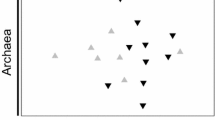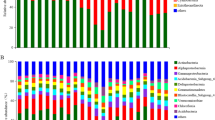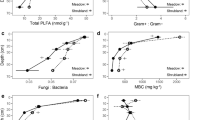Abstract
The interplay between plants and soil drives the structure and function of soil microbial communities. In water-limited environments where vascular plants are often absent and only specialized groups of rootless plants grow, this interaction could be mainly asymmetric, with plants supporting nutrients and resources via litter deposition. In this study, we use observational approaches to evaluate the impact of local distribution of Tillandsia landbeckii across elevation on soil bacterial community structure and composition in the Atacama Fog Desert. Tillandsia landbeckii is a plant without functional roots that develops on meter-scale sand dunes and depends mainly on marine fog that transports resources (water and nutrients) from the Pacific Ocean. Our data show that soil bacterial abundance, richness, and diversity were significantly higher beneath T. landbeckii plants relative to bare soils. However, these differences were not significant across T. landbeckii located at different elevations and with different input of marine fog. On the other hand, bacterial community composition was significantly different with T. landbeckii plants across elevations. Further, samples beneath T. landbeckii and bare soils showed significant differences in bacterial community composition. Around 99% of all operational taxonomic units (OTUs) were recorded exclusively beneath T. landbeckii, and only 1% of OTUs were observed in bare soils. These findings suggest that the presence of T. landbeckii promotes significant increases in bacterial abundance and diversity compared with bare soils, although we fail to demonstrate that local-scale changes in elevation can affect patterns of soil bacterial diversity and abundance beneath T. landbeckii.




Similar content being viewed by others
References
Araya JP, González M, Cardinale M, Schnell S, Stoll A (2020) Microbiome dynamics associated with the Atacama flowering desert. Frontiers Microbiol 10:3160. https://doi.org/10.3389/fmicb.2019.03160
Astorga-Eló M, Zhang Q, Larama G, Stoll A, Sadowsky MJ, Jorquera MA (2020) Composition, predicted functions and co-occurrence networks of rhizobacterial communities impacting flowering desert events in the Atacama Desert, Chile. Frontiers Microbiol 11:571. https://doi.org/10.3389/fmicb.2020.00571
Bardgett RD, Bowman WD, Kaufmann R, Schmidt SK (2005) A temporal approach to linking aboveground and belowground ecology. Trends Ecol Evol 20:634–641. https://doi.org/10.1016/j.tree.2005.08.005
Bauer JT, Mack KM, Bever JD (2015) Plant-soil feedbacks as drivers of succession: evidence from remnant and restored tallgrass prairies. Ecosphere 6:1–12. https://doi.org/10.1890/ES14-00480.1
Bennett JA, Klironomos J (2019) Mechanisms of plant–soil feedback: interactions among biotic and abiotic drivers. New Phytol 222:91–96. https://doi.org/10.1111/nph.15603
Bukowski AR, Schittko C, Petermann JS (2018) The strength of negative plant–soil feedback increases from the intraspecific to the interspecific and the functional group level. Ecol Evol 8:2280–2289. https://doi.org/10.1002/ece3.3755
Callahan BJ, McMurdie PJ, Rosen MJ, Han AW, Johnson AJA, Holmes SP (2016) DADA2: high-resolution sample inference from Illumina amplicon data. Nature Meth 13:581–583. https://doi.org/10.1038/nmeth.3869
Caporaso JG, Kuczynski J, Stombaugh J, Bittinger K, Bushman FD, Costello EK, Fierer N, Peña AG, Goodrich JK, Gordon JI, Huttley GA, Kelley ST, Knights D, Koenig JE, Ley RE, Lozupone CA, McDonald D, Muegge BD, Pirrung P, Reeder J, Sevinsky JR, Turnbaugh PJ, Walters WA, Widmann J, Yatsunenko T, Zaneveld J, Knight R (2010) QIIME allows analysis of high-throughput community sequencing data. Nature Meth 7:335–336. https://doi.org/10.1038/nmeth.f.303
Cereceda P, Larrain H, Lázaro P, Osses P, Schemenauer RS, Fuentes L (1999) Campos de tillandsias y niebla en el desierto de Tarapacá. Revista Geogra Norte Grande 26:3–13
Cheptsov V, Vorobyova E, Belov A, Pavlov A, Tsurkov D, Lomasov V, Bulat S (2018) Survivability of soil and permafrost microbial communities after irradiation with accelerated electrons under simulated Martian and open space conditions. Geosciences 8:298. https://doi.org/10.3390/geosciences8080298
Connon SA, Lester ED, Shafaat HS, Obenhuber DC, Ponce A (2007) Bacterial diversity in hyperarid Atacama Desert soils. J Geophys Res-Biogeo 112:G04S17. https://doi.org/10.1029/2006JG000311
Cordero RR, Damiani A, Jorquera J, Sepúlveda E, Caballero M, Fernandez S, Feron S, Llanillo PJ, Carrasco J, Laroze D, Labbe F (2018) Ultraviolet radiation in the Atacama Desert. Antonie van Leeuwenhoek 111:1301–1313. https://doi.org/10.1007/s10482-018-1075-z
Crawford KM, Bauer JT, Comita LS, Eppinga MB, Johnson DJ, Mangan SA, Queenborough SA, Strand AE, Suding KN, Umbanhowar J, Bever JD (2019) When and where plant-soil feedback may promote plant coexistence: a meta-analysis. Ecol Lett 22:1274–1284. https://doi.org/10.1111/ele.13278
Crits-Christoph A, Robinson CK, Barnum T, Fricke WF, Davila AF, Jedynak B, McKay CP, DiRuggiero J (2013) Colonization patterns of soil microbial communities in the Atacama Desert. Microbiome 1:1–13. https://doi.org/10.1186/2049-2618-1-28
De Deyn GB, Van der Putten WH (2005) Linking above-ground and belowground diversity. Trends Ecol Evol 20:625–633. https://doi.org/10.1016/j.tree.2005.08.009
De Long JR, Fry EL, Veen GF, Kardol P (2019) Why are plant–soil feedbacks so unpredictable, and what to do about it? Funct Ecol 33:118–128. https://doi.org/10.1111/1365-2435.13232
del Río C, Garcia JL, Osses P, Zanetta N, Lambert F, Rivera D, Siegmund A, Wolf N, Cereceda P, Larrain H, Lobos F (2018) ENSO influence on coastal fog-water yield in the Atacama Desert, Chile. Aerosol Air Qual Res 18:127–144. https://doi.org/10.4209/aaqr.2017.01.0022
Díaz FP, Frugone M, Gutiérrez RA, Latorre C (2016) Nitrogen cycling in an extreme hyperarid environment inferred from δ 15 N analyses of plants, soils and herbivore diet. Sci Rep 6:1–11. https://doi.org/10.1038/srep22226
Evans SE, Dueker ME, Logan JR, Weathers KC (2019) The biology of fog: results from coastal Maine and Namib Desert reveal common drivers of fog microbial composition. Sci Tot Environ 647:1547–1556. https://doi.org/10.1016/j.scitotenv.2018.08.045
González AL, Fariña JM, Pinto R, Pérez C, Weathers KC, Armesto JJ, Marquet PA (2011a) Bromeliad growth and stoichiometry: responses to atmospheric nutrient supply in fog-dependent ecosystems of the hyper-arid Atacama Desert, Chile. Oecologia 167:835–845. https://doi.org/10.1007/s00442-011-2032-y
González AL, Fariña JM, Kay AD, Pinto R, Marquet PA (2011b) Exploring patterns and mechanisms of interspecific and intraspecific variation in body elemental composition of desert consumers. Oikos 120:1247–1255. https://doi.org/10.1111/j.1600-0706.2010.19151.x
Jaeschke A, Böhm C, Merklinger FF, Bernasconi SM, Reyers M, Kusch S, Rethemeyer J (2019) Variation in δ15Nof fog-dependent Tillandsia ecosystems reflect water availability across climate gradients in the hyperarid AtacamaDesert. Global and Planetary Change 183: https://doi.org/10.1016/j.gloplacha.2019.103029
Klironomos JN (2002) Feedback with soil biota contributes to plant rarity and invasiveness in communities. Nature 417:67–70. https://doi.org/10.1038/417067a
Koch MA, Kleinpeter D, Auer E, Siegmund A, del Rio C, Osses P, Garcia JL, Marzol MV, Zizka G, Kiefer C (2019) Living at the dry limits: ecological genetics of Tillandsia landbeckii lomas in the Chilean Atacama Desert. Pl Syst Evol 305:1041–1053. https://doi.org/10.1007/s00606-019-01623-0
Koch MA, Stock C, Kleinpeter D, Del Rio C, Osses P, Merklinger FF, Quandt D, Siegmund A (2020) Vegetation growth and landscape genetics of Tillandsia lomas at their dry limits in the Atacama Desert show fine-scale response to environmental parameters. Ecol Evol 10:13260–13274. https://doi.org/10.1002/ece3.6924
Latorre C, González AL, Quade J, Fariña JM, Pinto R, Marquet PA (2011) Establishment and formation of fog-dependent Tillandsia landbeckii dunes in the Atacama Desert: Evidence from radiocarbon and stable isotopes. J Geophys Res Biogeosci 116:1–12. https://doi.org/10.1029/2010JG001521
Lauber CL, Strickland MS, Bradford MA, Fierer N (2008) The influence of soil properties on the structure of bacterial and fungal communities across land-use types. Soil Biol Biochem 40:2407–2415. https://doi.org/10.1016/j.soilbio.2008.05.021
Lekberg Y, Bever JD, Bunn RA, Callaway RM, Hart MM, Kivlin SN, Klironomos J, Larkin BG, Maron JL, Reinhart KO, Remke M, van der Putten WH (2018) Relative importance of competition and plant–soil feedback, their synergy, context dependency and implications for coexistence. Ecol Lett 21:1268–1281. https://doi.org/10.1111/ele.13093
Makhalanyane TP, Valverde A, Gunnigle E, Frossard A, Ramond JB, Cowan DA (2015) Microbial ecology of hot desert edaphic systems. FEMS Microbiol Rev 39:203–221. https://doi.org/10.1093/femsre/fuu011
Mangan S, Schnitzer S, Herre EA, Mack KML, Valencia MC, Sanchez EI, Bever JD (2010) Negative plant–soil feedback predicts tree-species relative abundance in a tropical forest. Nature 466:752–755. https://doi.org/10.1038/nature09273
Neilson JW, Quade J, Ortiz M, Nelson WM, Legatzki A, Tian F, LaComb M, Betancourt JL, Wing RA, Soderlund CA, Maier RM (2012) Life at the hyperarid margin: novel bacterial diversity in arid soils of the Atacama Desert, Chile. Extremophiles. 16:553–566. https://doi.org/10.1007/s00792-012-0454-z
Niering WA, Whittaker RH, Lowe CH (1963) The Saguaro: A population in relation to environment. Science 142:15–23. https://doi.org/10.1126/science.142.3588.15
Orellana R, Macaya C, Bravo G, Dorochesi F, Cumsille A, Valencia R, Rojas C, Seeger M (2018) Living at the frontiers of life: extremophiles in Chile and their potential for bioremediation. Frontiers Microbiol 9:2309. https://doi.org/10.3389/fmicb.2018.02309
Raux PS, Gravelle S, Dumais J (2020) Design of a unidirectional water valve in Tillandsia. Nature Commun 11:1–7. https://doi.org/10.1038/s41467-019-14236-5
Reverdy A, Hathaway D, Jha J, Sullivan J, Michaels G, Mac-Adoo DD, Riquelme C, Chai Y, Godoy VG (2020) Insights into the diversity and survival strategies of soil bacterial isolates from the Atacama Desert. bioRxiv 2020:09.24.312199. https://doi.org/10.1101/2020.09.24.312199
Rundel PW, Palma B, Dillon MO, Sharifi MR, Nilsen ET, Boonpragob K (1997) Tillandsia landbeckii in the coastal Atacama Desert of northern Chile. Revista Chilena Hist Nat 70:341–349
Sghaier H, Hezbri K, Ghodhbane-Gtari F, Pujic P, Sen A, Daffonchio D, Boudabous A, Tisa LS, Klenk HP, Armengaud J, Normand P, Gtari M (2016) Stone-dwelling Actinobacteria Blastococcus saxobsidens, Modestobacter marinus and Geodermatophilus obscurus proteogenomes. ISME J 10:21–29. https://doi.org/10.1038/ismej.2015.108
Smith-Ramesh LM (2018) Predators in the plant–soil feedback loop: aboveground plant-associated predators may alter the outcome of plant–soil interactions. Ecol Letters 21:646–654. https://doi.org/10.1111/ele.12931
Templer PH, Weathers KC, Ewing HA, Dawson TE, Mambelli S, Lindsey AM, Webb J, Boukili VK, Firestone MK (2015) Fog as a source of nitrogen for redwood trees: evidence from fluxes and stable isotopes. J Ecol 103:1397–1407. https://doi.org/10.1111/1365-2745.12462
Wang F, Michalski G, Seo JH, Granger DE, Lifton N, Caffee M (2015) Beryllium-10 concentrations in the hyper-arid soils in the Atacama Desert, Chile: Implications for arid soil formation rates and El Niño driven changes in Pliocene precipitation. Geochim Cosmochimi Acta 160:227–242. https://doi.org/10.1016/j.gca.2015.03.008
Wardle DA, Bardgett RD, Klironomos JN, Setälä H, Van Der Putten WH, Wall DH (2004) Ecological linkages between aboveground and belowground biota. Science 304:1629–1633. https://doi.org/10.1126/science.1094875
Wardle DA (2006) The influence of biotic interactions on soil biodiversity. Ecol Lett 9:870–886. https://doi.org/10.1111/j.1461-0248.2006.00931.x
Warren-Rhodes KA, Rhodes KL, Pointing SB, Ewing SA, Lacap DC, Gomez-Silva B, Amundson R, Friedmann EI, McKay CP (2006) Hypolithic cyanobacteria, dry limit of photosynthesis, and microbial ecology in the hyperarid Atacama Desert. Microbial Ecol 52:389–398. https://doi.org/10.1007/s00248-006-9055-7
Weathers KC (1999) The importance of cloud and fog in the maintenance of ecosystems. Trends Ecol Evol 6:214–215. https://doi.org/10.1016/S0169-5347(99)01635-3
Weathers KC, Ponette-González AG, Dawson TE (2020) Medium, Vector, and Connector: Fog and the Maintenance of Ecosystems. Ecosystems 23:217–229. https://doi.org/10.1007/s10021-019-00388-4
Westbeld A, Klemm O, Grießbaum F, Sträter E, Larrain H, Osses P, Cereceda P (2009) Fog deposition to a Tillandsia carpet in the Atacama Desert. Ann Geophys 27:3571–3576. https://doi.org/10.5194/angeo-27-3571-2009
Wolf N, Siegmund A, Del Río C, Osses P, García JL (2016) Remote Sensing-Based Detection and Spatial Pattern Analysis for Geo-Ecological Niche Modeling of Tillandsia SPP. In the Atacama, Chile. Int Arch Photogramm Remote Sensing Spatial Inform Sci 2:251–256
Zanetta N; del Río C, Osses P, García JL, Luengo Y, Wolf N, Siegmund A (2016) Spatio-temporal variability of fog water and its meteorological conditions in the coastal Atacama Desert, Chile. In: M Błaś, M Sobik (eds) 7th International Conference on Fog, Fog Collection and Dew. Wroclaw, Poland, 24 – 29 July, Proceedings book. FFCD, Wroclaw, pp 122–125
Acknowledgements
This study was supported by FONDECYT 11180538, Agencia Nacional de Investigación y Desarrollo (ANID), Chile and the Start-Up grants of the Vicerrectoría de Investigación (VRI), Universidad Mayor, Chile. F.D.A and S.A. were supported by FONDECYT 1170995. We thank Centro UC Desierto de Atacama for logistic and technical support.
Author information
Authors and Affiliations
Contributions
FDA conceived the project and the experiments. FDA and CV conducted the sampling, MM and CA analyzed soil samples, JLG, PO, CDR, CL, and MAK assisted with data analysis and site information, and FDA and SA drafted the manuscript. All authors contributed to the final manuscript draft.
Corresponding author
Ethics declarations
Conflict of interest
The authors declare that they do have no conflict of interest.
Additional information
Handling editor: Dietmar Quandt.
Publisher's Note
Springer Nature remains neutral with regard to jurisdictional claims in published maps and institutional affiliations.
Contribution to “Living at its dry limits - Tillandsiales in the Atacama Desert”.
Supplementary Information
Below is the link to the electronic supplementary material.
Information on Electronic Supplementary Material
Information on Electronic Supplementary Material
Online Resource 1. Elevational distribution of Tillandsia landbeckii bands along the Oyarbide field.
Online Resource 2. Ordinary least squares (OLS) regression for assessing the effect of change in band and inter-band elevation on soil features and bacterial diversity beneath Tillandsia landbeckii and bare soils across the elevation gradient in the Oyarbide field.
Online Resource 3. Rarefaction curves of observed OTUs of soil bacterial communities beneath Tillandsia landbeckii and bare soils across the elevation gradient in the Oyarbide field.
Online Resource 4. Ordinary least squares (OLS) regression for assess the effect of change in elevation on soil bacterial diversity (at phylum level) beneath Tillandsia landbeckii and bare soils across the elevation gradient in the Oyarbide field.
Online Resource 5. Phyla relative abundance in soils beneath Tillandsia landbeckii across the elevation gradient in the Oyarbide field.
Online Resource 6. Mantel and Partial Mantel test of bacterial community composition and geographic distance corrected by changes in soil TC across different elevations in the Oyarbide field.
Rights and permissions
About this article
Cite this article
Alfaro, F.D., Manzano, M., Almiray, C. et al. Soil bacterial community structure of fog‐dependent Tillandsia landbeckii dunes in the Atacama Desert. Plant Syst Evol 307, 56 (2021). https://doi.org/10.1007/s00606-021-01781-0
Received:
Accepted:
Published:
DOI: https://doi.org/10.1007/s00606-021-01781-0




